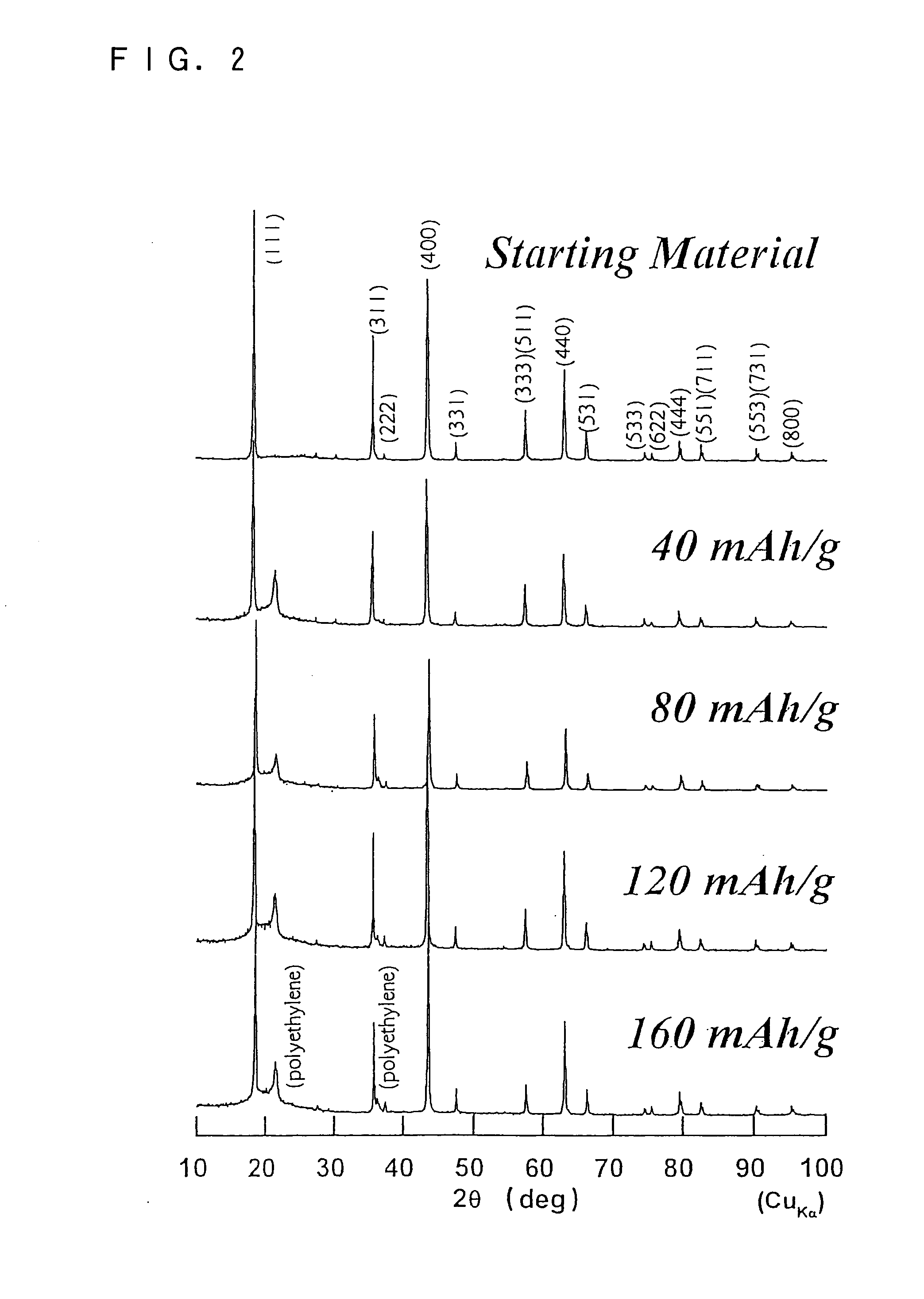Non-aqueous electrolyte secondary battery
a secondary battery and non-aqueous electrolyte technology, applied in the field of non-aqueous electrolyte secondary batteries, can solve the problems low cycle life, and inability to fundamentally solve the problem of deterioration during storage and low cycle life, and increase the cost of the battery
- Summary
- Abstract
- Description
- Claims
- Application Information
AI Technical Summary
Benefits of technology
Problems solved by technology
Method used
Image
Examples
example 1
[0114] Firstly, two different types of positive electrode active materials were prepared by the following procedure. [Ni1 / 2Co1 / 2](OH)2 or [Ni1 / 3Mn1 / 3Co1 / 3](OH)2 obtained by coprecipitation was thoroughly mixed with LiOH.H2O, which was then formed into pellets and baked. Li1±xNi1 / 2Co1 / 2O2 (x≦0.1) was obtained by baking at 900° C. Li1±xNi1 / 3Co1 / 3Mn1 / 3O2 (x≦0.1) was obtained by baking at 1000° C.
[0115] Subsequently, unit cells for electrochemical testing were produced using the positive electrode active materials prepared above in the following manner. A mixture containing 80 parts by weight of the above-obtained positive electrode active material Li1±xNi1 / 2Co1 / 2O2 or Li1±xNi1 / 3Co1 / 3Mn1 / 3O2, 10 parts by weight of acetylene black as a conductive material and 10 parts by weight of PVdF (polyvinylidene fluoride) as a binder was diluted with NMP (N-methyl-2-pyrrolidone). The obtained mixture was applied onto a current collector made of aluminum foil, which was then dried in a vacuum at 60...
example 2
[0119] In this example, cylindrical batteries as shown in FIG. 16 were produced.
[0120] A battery case 1 was made of nickel-plated iron. A positive electrode lead 5 and a negative electrode lead 6 were made of aluminum and stainless steel, respectively.
[0121] The positive electrode (plate) was produced as follows. Firstly, 85 parts by weight of the powdered positive electrode active material Li1±xNi1 / 2Co1 / 2O2 (x≦0.1) or Li1±xNi1 / 3Co1 / 3Mn1 / 3O2 (x≦0.1) was mixed with 10 parts by weight of carbonaceous powders as a conductive material and 5 parts by weight of polyvinylidene fluoride resin as a binder. The obtained mixture was dispersed in dehydrated N-methyl-pyrrolidinone to give a slurry. The slurry was applied onto a positive electrode current collector made of aluminum foil, which was then dried, rolled and cut into pieces of a predetermined size to give a positive electrode.
[0122] The negative electrode was produced in the same manner as the positive electrode was made except tha...
example 3
[0126] This example examined the preferred capacity design of the positive and negative electrodes in the present invention. Cylindrical batteries were produced in the same manner as in EXAMPLE 2 using different weight ratios between the positive electrode active material per unit area of the positive electrode plate and the negative electrode active material per unit area of the negative electrode plate. The cycle life of each of the produced cylindrical batteries was measured. The results are shown in Table 2. In the charge and discharge cycles, charging was performed at a constant voltage of 5 V with a maximum current of 1 C. The charging was stopped two hours after the start of charging. Discharging was performed, on the other hand, at a constant current of 2 C to 1.0 V. Table 2 shows the number of cycles when the discharge capacity decreased to 98% of the initial capacity.
TABLE 2Weight ratio ofnegative electrode active materialtoNumber of cyclespositive electrode active mater...
PUM
| Property | Measurement | Unit |
|---|---|---|
| particle size | aaaaa | aaaaa |
| particle size | aaaaa | aaaaa |
| particle size | aaaaa | aaaaa |
Abstract
Description
Claims
Application Information
 Login to View More
Login to View More - R&D
- Intellectual Property
- Life Sciences
- Materials
- Tech Scout
- Unparalleled Data Quality
- Higher Quality Content
- 60% Fewer Hallucinations
Browse by: Latest US Patents, China's latest patents, Technical Efficacy Thesaurus, Application Domain, Technology Topic, Popular Technical Reports.
© 2025 PatSnap. All rights reserved.Legal|Privacy policy|Modern Slavery Act Transparency Statement|Sitemap|About US| Contact US: help@patsnap.com



